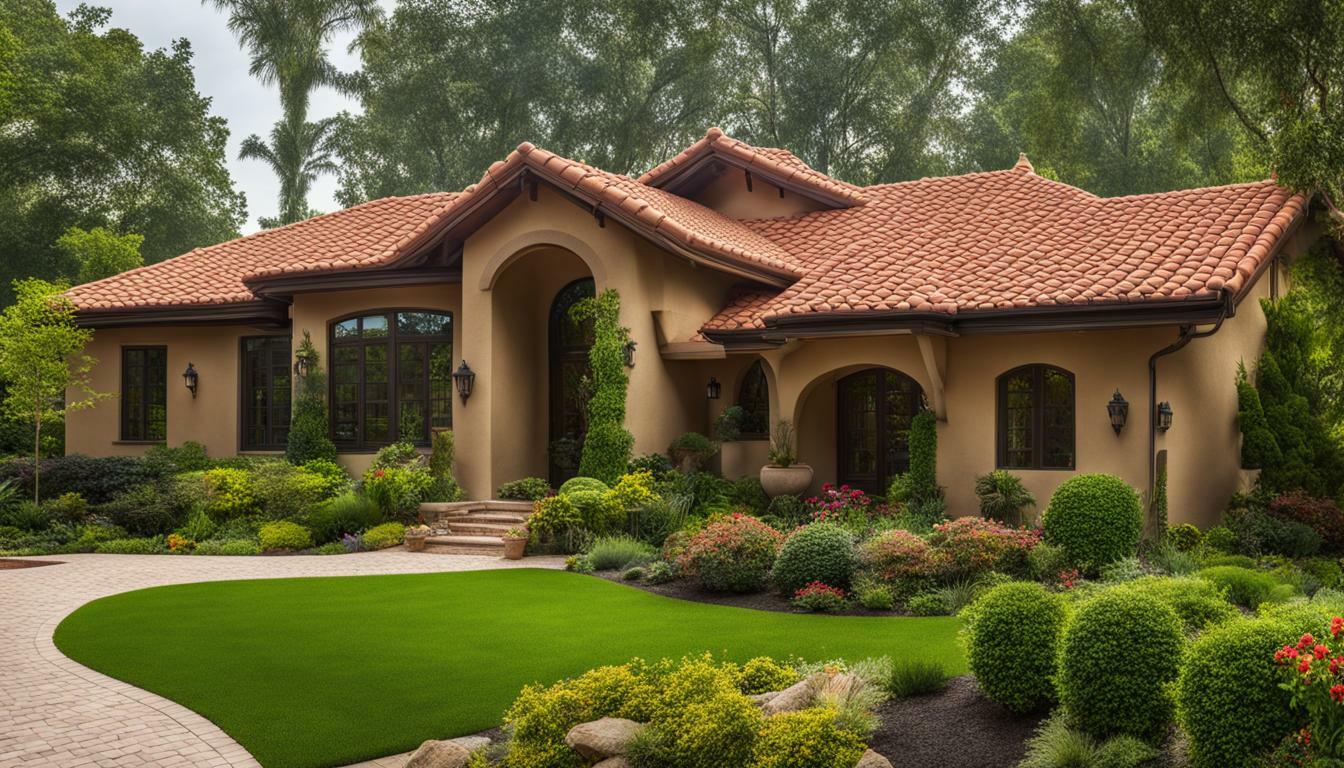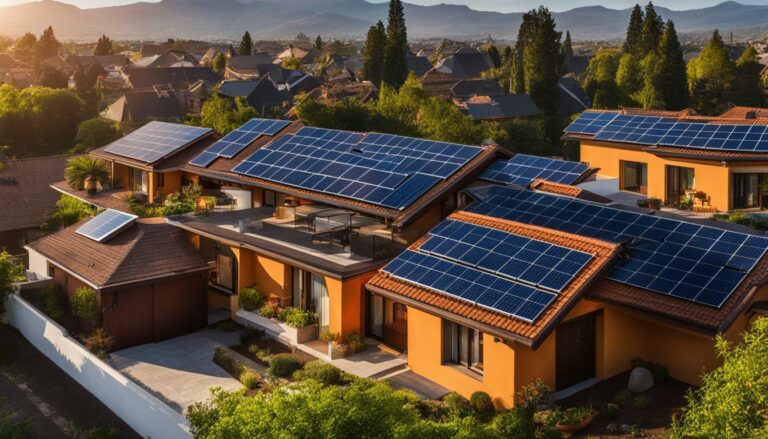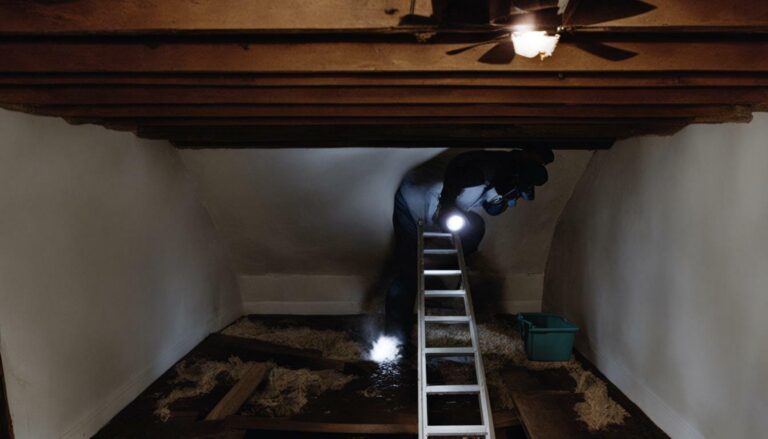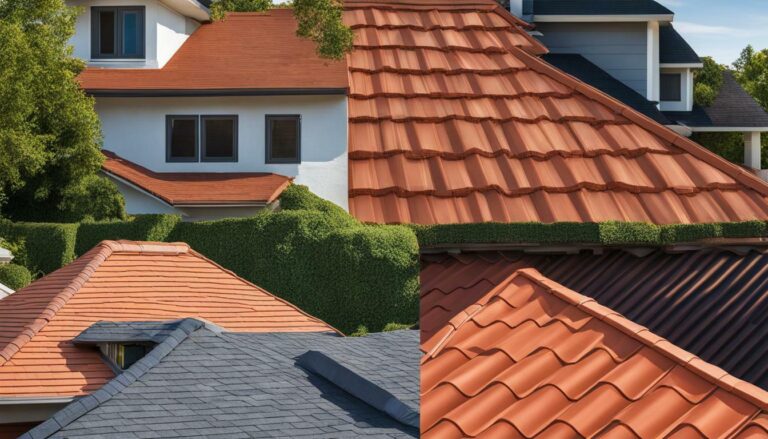Exploring Clay Tile Roof Pros and Cons: A Guide for Homeowners
Clay tile roofs offer homeowners a variety of benefits, but they also have some drawbacks that need to be taken into account. These roofs are known for their versatility, durability, and longevity. They can withstand threats such as fire, wind, sun, snow, and hail, making them a reliable option for homeowners in various climates. Additionally, clay tile roofs provide excellent insulation, keeping homes cool in hot weather and warm in cold weather. With proper installation and maintenance, these roofs can last for 100 years or more, offering long-term durability and peace of mind.
- Clay tile roofs are versatile, durable, and long-lasting.
- They can withstand various weather conditions, including fire, wind, sun, snow, and hail.
- Clay tile roofs provide excellent insulation, resulting in energy efficiency and comfortable indoor temperatures.
- There are some drawbacks to consider, including the potential for breakage during installation and the higher cost compared to asphalt shingles.
- Maintenance requirements for clay tile roofs are generally low, but homeowners should be aware of specific tasks to ensure their longevity.
The Benefits of Clay Tile Roofs
There are several compelling reasons why homeowners may choose clay tile roofs for their homes. Clay tiles offer a variety of features and benefits that make them a popular roofing choice. One of the key advantages of clay tile roofs is their versatility. These tiles come in a wide range of colors and styles, allowing homeowners to achieve the desired aesthetic for their homes. Whether you prefer the classic look of barrel tiles, the sleekness of flat tiles, or the elegance of French or Spanish tiles, clay roof tiles can enhance the curb appeal of any home.
Another significant benefit of clay tile roofs is their durability and longevity. Clay tiles are known for their ability to withstand extreme weather conditions, including fire, wind, sun, snow, and hail. With proper installation and maintenance, clay tile roofs can last for over 100 years, making them a long-lasting investment for homeowners.
Furthermore, clay tile roofs offer excellent insulation properties. These tiles provide effective thermal regulation, helping to keep homes cool during hot summer months and warm during colder seasons. The insulation benefits of clay roof tiles can contribute to energy savings and create a comfortable indoor environment.
| Advantages of Clay Tile Roofs: |
|---|
| Versatility in colors and styles |
| Durability and longevity |
| Excellent insulation properties |
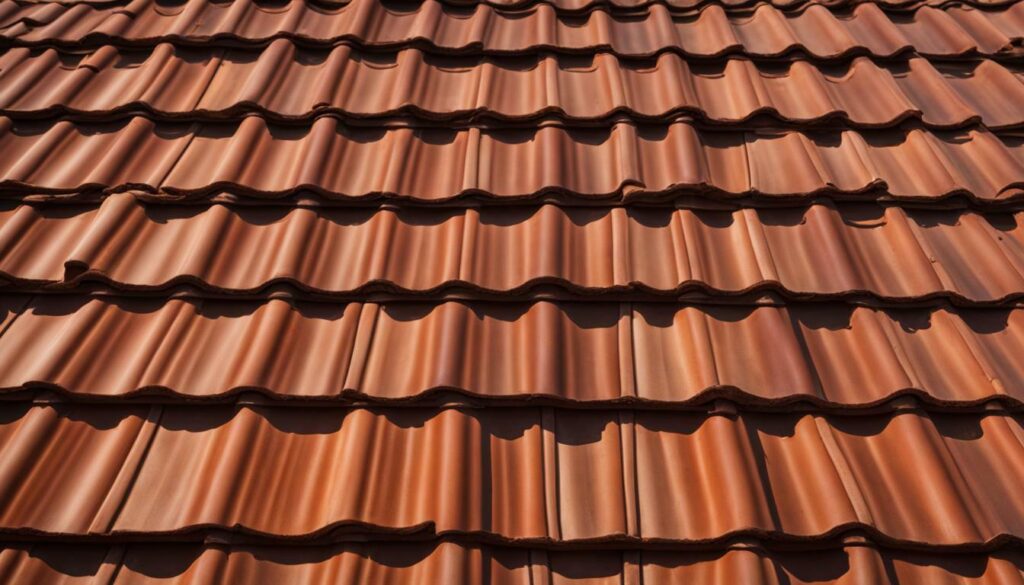
Clay tile roofs offer excellent insulation properties, helping to keep homes cool in hot weather and warm in cold weather.
In conclusion, clay tile roofs provide numerous advantages for homeowners. Their versatility in colors and styles allows for customization, enhancing the overall aesthetic appeal of a home. Additionally, the durability and longevity of clay tile roofs make them a wise long-term investment. The insulation properties they offer contribute to energy efficiency and provide a comfortable living environment. While clay tile roofs may have a higher initial cost and require a structurally capable roof structure, their benefits outweigh the disadvantages. Overall, clay tile roofs offer homeowners a durable, aesthetically pleasing, and practical roofing option.
The Drawbacks of Clay Tile Roofs
While clay tile roofs have numerous benefits, they are not without some drawbacks that homeowners should consider. One of the main disadvantages of clay tiles is their brittleness, which makes them susceptible to breakage during installation. This requires careful handling and professional installation to minimize the risk of damage. Additionally, clay tile roofs are heavier than other roofing materials, such as asphalt shingles. This means that they require a structurally capable roof structure to support the weight, which may involve additional construction costs.
Another drawback of clay tile roofs is their higher initial cost compared to other roofing options. The materials and installation for a clay tile roof can be more expensive upfront. However, it’s important to note that clay tile roofs have a longer lifespan than many other roofing materials. With proper maintenance, a clay tile roof can last for over a century, potentially offsetting the initial investment over time.
Maintenance requirements are another consideration when it comes to clay tile roofs. While they are generally low maintenance, periodic inspections and repairs may be necessary to ensure their longevity. For example, cracked or damaged tiles should be replaced promptly to prevent further damage. It’s recommended to consult with a professional roofer for regular maintenance and any necessary repairs.
Despite these drawbacks, clay tile roofs offer several advantages that may outweigh their disadvantages for many homeowners. From their durability and longevity to their energy efficiency and improved curb appeal, clay tile roofs provide a high-quality option for those seeking both functional and aesthetically pleasing roofing solutions. It’s important to carefully evaluate the pros and cons of clay tile roofs, taking into account individual needs, budget, and structural considerations before making a decision.
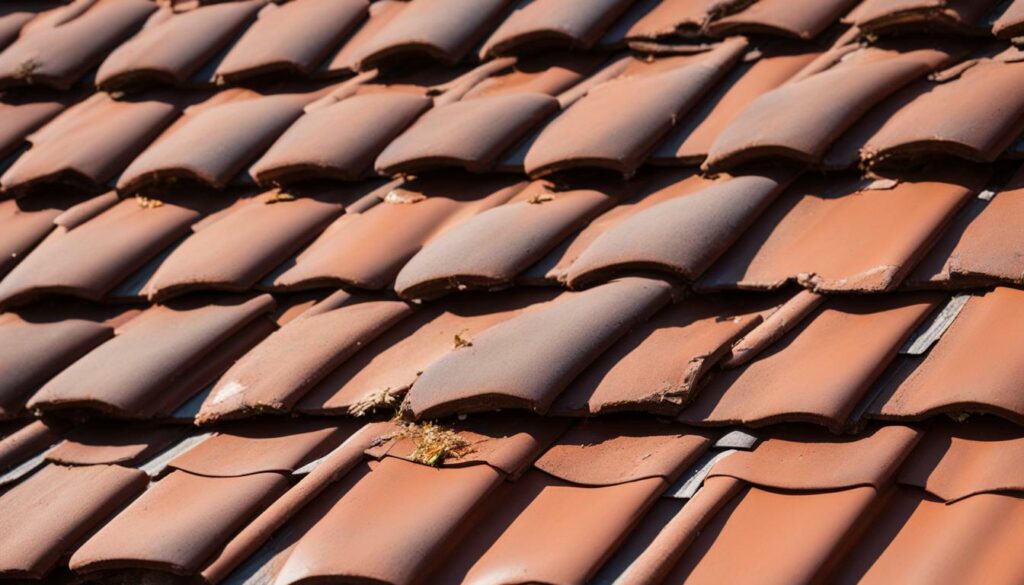
| Pros | Cons |
|---|---|
| Versatility in design and style options | Brittleness and susceptibility to breakage during installation |
| Durability and longevity | Higher initial cost compared to other roofing materials |
| Resistance to fire, wind, sun, snow, and hail | Requires a structurally capable roof structure |
| Energy efficiency and insulation properties | Periodic maintenance and repairs may be needed |
| Improved curb appeal with a variety of colors and styles | |
| Low maintenance requirements |
“While clay tile roofs have some drawbacks, their benefits outweigh the disadvantages for many homeowners. With their long lifespan, energy efficiency, and enhanced aesthetics, clay tile roofs provide a durable and attractive option.”
Durability and Longevity of Clay Tile Roofs
One of the most significant advantages of clay tile roofs is their exceptional durability and impressive lifespan. These roofs are built to withstand a range of threats, making them a reliable and long-lasting option for homeowners. Clay tiles have a natural resistance to fire, making them an excellent choice for areas prone to wildfires. Additionally, they can withstand strong winds, ensuring that your roof remains intact during storms and gusts. The sun’s harsh rays won’t cause premature deterioration either, as clay tiles are resistant to UV damage. Even heavy snowfall and hail pose little risk to a properly installed clay tile roof.
Clay tile roofs can be an investment that lasts a lifetime. With proper installation and maintenance, these roofs can easily surpass the century mark in terms of lifespan. Unlike other roofing materials that may need to be replaced every few decades, clay tiles offer unparalleled longevity. This means that once you install a clay tile roof, you can enjoy its benefits and aesthetic appeal without worrying about re-roofing for many years to come. It’s a durable and reliable option that provides peace of mind and reduces long-term costs.
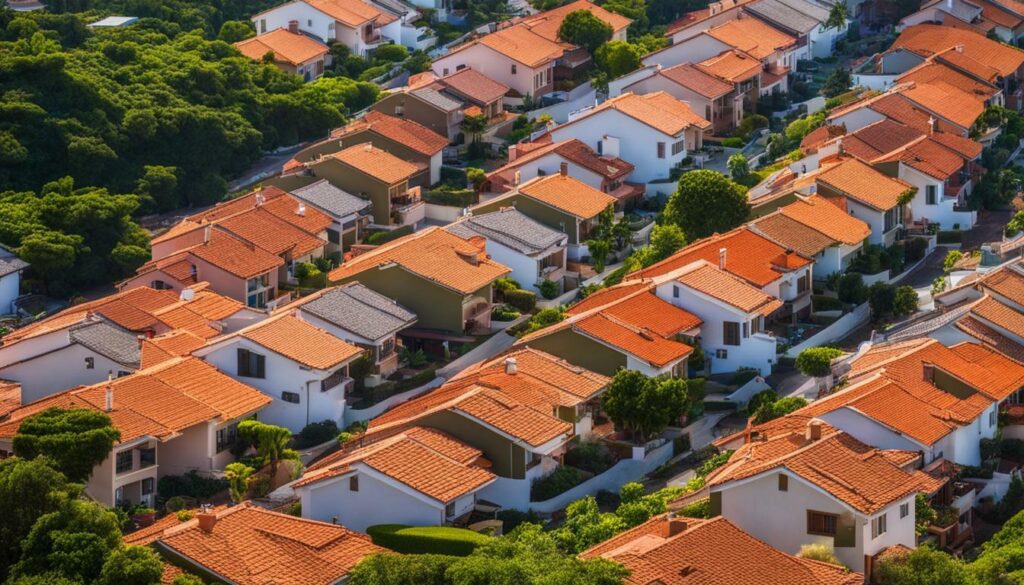
When considering the durability and longevity of clay tile roofs, it’s important to note that proper installation and maintenance play a crucial role. Hiring experienced professionals to install your clay tile roof ensures that it is set up for success from the start. Routine inspections and maintenance, such as clearing debris, inspecting for any cracked or damaged tiles, and addressing any issues promptly, will help prolong the life of your roof.
In summary, clay tile roofs offer homeowners a roofing solution that is not only aesthetically pleasing but also remarkably durable and long-lasting. Their ability to withstand fire, wind, sun, snow, and hail, coupled with their impressive lifespan, make them an excellent investment for homeowners seeking a roof that will stand the test of time. With proper installation and maintenance, clay tile roofs can provide reliable protection for your home for more than a century. Consider the advantages and drawbacks, assess your specific requirements and costs, and make an informed decision when choosing your roofing option.
Energy Efficiency and Insulation
Clay tile roofs not only provide protection against the elements but also offer excellent insulation benefits for homeowners. The natural composition of clay tiles helps regulate temperature, keeping homes cooler in hot weather and warmer in cold weather. This energy efficiency can lead to lower heating and cooling costs, making clay tile roofs an economically sound choice in the long run.
One of the key factors contributing to the insulation benefits of clay tile roofs is their thermal mass properties. Thermal mass refers to the ability of a material to absorb and store heat energy. Clay tiles have a high thermal mass, which means they can absorb heat during the day and release it slowly at night, helping to maintain a comfortable indoor temperature.
| Insulation Benefits of Clay Tile Roofs | Advantages |
|---|---|
| Reduced energy consumption | Lower heating and cooling costs |
| Enhanced indoor comfort | Maintains consistent temperatures |
| Environmentally friendly | Reduces carbon footprint |
Furthermore, the thermal properties of clay tiles contribute to a reduction in carbon footprint. By reducing the reliance on heating and cooling systems, homeowners can lower their energy consumption and minimize their impact on the environment. The energy efficiency of clay tile roofs aligns with sustainable living practices and can be a valuable consideration for environmentally conscious homeowners.

Overall, the insulation benefits of clay tile roofs make them a popular choice for homeowners looking to maintain comfortable indoor temperatures while reducing energy consumption. The thermal mass properties of clay tiles contribute to a more energy-efficient home, resulting in lower utility bills and a reduced carbon footprint. If you’re considering a new roof, clay tiles can offer both aesthetic appeal and practical advantages in terms of energy efficiency and insulation.
Improved Curb Appeal
Choosing a clay tile roof not only offers functional benefits but also adds a touch of elegance and charm to a home’s exterior. The wide range of colors and styles available in clay tile roofs allows homeowners to enhance the curb appeal of their property and create a unique and visually striking look.
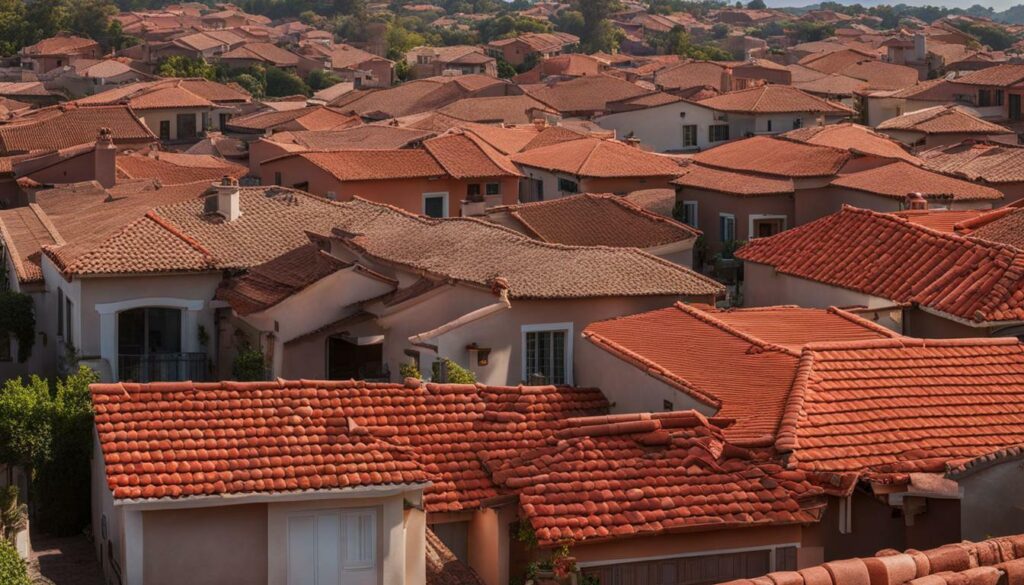
Clay tile roofs come in various styles, including barrel tiles, flat tiles, French tiles, and Spanish tiles. Each style offers its own distinct aesthetic, allowing homeowners to choose the one that best complements their architectural design and personal taste. Whether you prefer a traditional, rustic, or contemporary look, there is a clay tile roof style that can perfectly fit your vision.
The color options for clay tile roofs are equally diverse, ranging from earthy terracottas to rich blues, greens, and browns. This wide array of colors allows homeowners to customize their roof to coordinate with the overall color scheme of their home and create a cohesive and visually appealing exterior.
| Clay Tile Roof Styles | Clay Tile Roof Colors |
|---|---|
| Barrel tiles | Earthy terracottas |
| Flat tiles | Rich blues |
| French tiles | Greens |
| Spanish tiles | Browns |
By choosing a clay tile roof, homeowners can not only protect their property but also make a statement with a beautiful and distinctive roof that enhances the overall aesthetics and curb appeal of their home.
Maintenance Requirements
One of the advantages of clay tile roofs is their minimal maintenance needs, making them an attractive option for homeowners. Clay tiles are resistant to rot, insects, and decay, reducing the likelihood of costly repairs or replacements. However, there are still some maintenance considerations to keep in mind to ensure the longevity of your clay tile roof.
- Inspect your roof regularly: Regular inspections can help identify any potential issues before they escalate. Look for cracked or broken tiles, loose or damaged flashing, and signs of debris or moss buildup.
- Clean your roof periodically: While clay tiles are naturally resistant to mold and algae growth, it’s still a good idea to clean your roof periodically to remove any dirt or debris that may accumulate. Use a soft bristle brush or a gentle power wash to avoid damaging the tiles.
- Trim surrounding foliage: Overhanging tree branches can pose a risk to your clay tile roof. Trim back any branches that are in close proximity to prevent potential damage from falling debris or rubbing against the tiles.
- Address repairs promptly: If you notice any cracked or broken tiles, it’s important to address the repairs promptly. Leaving damaged tiles untreated can lead to water leaks and further damage to your roof and home.
Table 1: Maintenance Tasks for Clay Tile Roofs
| Maintenance Task | Frequency |
|---|---|
| Inspect roof | Annually or after severe weather conditions |
| Clean roof | Every 2-3 years or as needed |
| Trim surrounding foliage | Regularly as needed |
| Address repairs | As soon as damage is noticed |
Remember, proper maintenance plays a crucial role in maximizing the lifespan of your clay tile roof. By following these maintenance tasks and addressing any repairs promptly, you can ensure that your roof remains in excellent condition for many years to come.

While clay tile roofs offer numerous benefits, it’s important for homeowners to consider the upfront cost and long-term financial implications. Clay tiles are typically more expensive than traditional asphalt shingles, and this higher initial cost can be a deterrent for some homeowners. However, it’s essential to remember that clay tile roofs offer exceptional durability and longevity, which can offset the initial investment over time.
When comparing the cost of clay tile roofs to asphalt shingles, it’s essential to consider the lifespan of each roofing material. While asphalt shingles may have a lower upfront cost, they typically have a much shorter lifespan, averaging around 20-30 years. In contrast, clay tile roofs can last for 100 years or more when properly installed and maintained. This longevity means that homeowners won’t have to worry about the cost and hassle of frequent roof replacements, saving them significant expenses in the long run.
Additionally, clay tile roofs can contribute to energy savings, which can further offset their initial cost. Their insulation properties help regulate temperature fluctuations in the home, reducing the reliance on heating and cooling systems and lowering energy bills over time.
| Roofing Material | Upfront Cost | Lifespan | Long-Term Savings |
|---|---|---|---|
| Clay Tile Roof | Higher cost | 100+ years | Lower maintenance and replacement costs |
| Asphalt Shingle Roof | Lower cost | 20-30 years | Potential for higher maintenance and replacement costs |
When considering the cost of a clay tile roof, it’s crucial to weigh the upfront investment against the long-term benefits and savings. Consulting with roofing professionals and obtaining multiple quotes can help homeowners make an informed decision that aligns with their budget and goals. By understanding the cost considerations and potential financial implications, homeowners can confidently choose a roofing option that offers both aesthetic appeal and long-term value.
Conclusion
Clay tile roofs offer homeowners a durable and aesthetically pleasing option, but it’s crucial to carefully evaluate the pros and cons before choosing this roofing material. There are several benefits to consider. These roofs are versatile, providing a timeless and elegant look to any home. Furthermore, clay tiles are highly durable and can withstand various threats such as fire, wind, sun, snow, and hail. They also offer excellent insulation properties, keeping your home cool during hot weather and warm during cold weather.
With proper installation and maintenance, clay tile roofs have an impressive lifespan of 100 years or more. They require minimal upkeep, as they are resistant to rot, insects, and decay. In terms of aesthetics, clay tile roofs come in a wide range of colors and styles, allowing homeowners to find the perfect match for their home’s exterior. Whether you prefer the classic look of barrel tiles, the sleekness of flat tiles, or the charm of French or Spanish tiles, clay roofs offer many options to enhance your curb appeal.
However, it’s essential to consider the drawbacks as well. Clay tiles are brittle and can easily break during the installation process, requiring caution and expertise from professionals. Additionally, clay tile roofs come with a higher price tag compared to traditional asphalt shingles. The weight of the tiles also necessitates a structurally capable roof structure to support the load.
In conclusion, clay tile roofs provide homeowners with a durable and visually appealing choice for their roofing needs. They offer benefits such as energy efficiency, improved curb appeal, and low maintenance requirements. However, it’s crucial to assess your specific requirements and carefully consider the costs before making a decision. By weighing the pros and cons, you can determine if a clay tile roof is the right choice for you and your home.
FAQ
Q: What are the benefits of clay tile roofs?
A: Clay tile roofs offer versatility, durability, and longevity. They can withstand threats such as fire, wind, sun, snow, and hail. They also provide insulation to keep homes cool in hot weather and warm in cold weather.
Q: What are the drawbacks of clay tile roofs?
A: Clay tiles are brittle and easily break during installation. They are also more expensive than asphalt shingles and require a structurally capable roof structure. Additionally, they can be heavy and may require extra reinforcement.
Q: How durable and long-lasting are clay tile roofs?
A: With proper installation and maintenance, clay tile roofs can last 100 or more years. They are highly resistant to fire, wind, sun, snow, and hail, making them a durable option for homeowners.
Q: Do clay tile roofs provide energy efficiency and insulation?
A: Yes, clay tile roofs have insulation properties that help to keep homes cool in hot weather and warm in cold weather. This can contribute to energy savings and a comfortable indoor temperature.
Q: Do clay tile roofs improve curb appeal?
A: Yes, clay tile roofs come in a variety of colors and styles, including barrel tiles, flat tiles, French tiles, and Spanish tiles. This wide range of options allows homeowners to enhance the aesthetic appeal of their homes.
Q: Are clay tile roofs low maintenance?
A: Yes, clay tile roofs are generally low maintenance. They are resistant to rot, insects, and decay. However, periodic inspections and maintenance tasks, such as cleaning and moss removal, may be necessary to ensure the longevity of the roof.
Q: How much do clay tile roofs cost?
A: Clay tile roofs are more expensive than traditional asphalt shingles. The exact cost will depend on factors such as the size of the roof, the type of clay tile, and the complexity of the installation. However, it’s important to consider the long-term durability and potential energy savings when assessing the overall cost.
